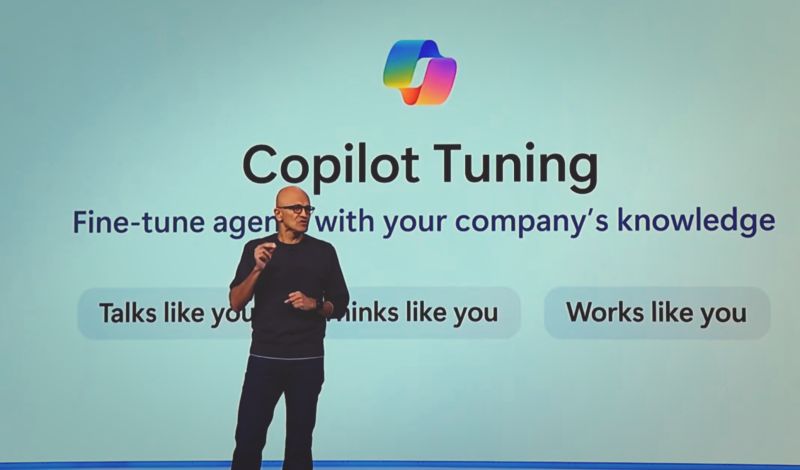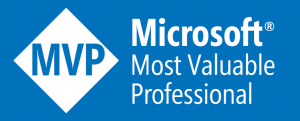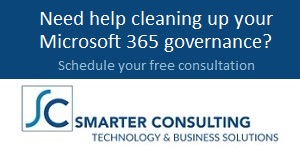Why Copilot needs to speak your language
We’ve all seen it: the wow factor of Microsoft Copilot when it writes, summarizes, or automates with just a sentence of input. I love providing demos to people new to the technology and showing them just how much the technology can improve personal productivity. But as people start working with it and some of the novelty wears off, a pattern emerges. Copilot is great at general tasks, but often struggles when it runs into the specifics of your world—your product lines, your acronyms, your playbooks, your tone.

Microsoft CEO Satya Nadella talking Copilot Tuning
That’s the gap. And it’s where Copilot becomes something far more useful if you take the time to feed it the right knowledge.
As a holdover from my SharePoint vernacular, I keep referring to this as “domain-specific knowledge packs.” Microsoft doesn’t use that exact phrase, but their tooling now fully supports this idea: shaping Copilot with your internal data so it can reason like someone inside your business, not just a general AI assistant trained on the internet.
So how do you do that? Let’s break it down.
Start by Defining Your Knowledge Domains
Before you build anything, you need to know what you’re teaching Copilot and why. This isn’t about throwing every document you’ve got at the system. It’s about being strategic.
Think in terms of “domains”—which in this case, are task-oriented areas of expertise inside your business. It might be “customer onboarding,” or “RFP responses,” or “product warranty support.” These are the areas where Copilot struggles with generic knowledge and where a little specificity goes a long way.
The process starts with inventorying your internal assets: SharePoint folders, PDFs, case studies, meeting transcripts, knowledge base articles, Teams messages. Anything that reflects how your people work and communicate around that domain. Once you’ve got a shortlist, work with your SMEs to tag the most trusted and representative documents. That becomes your raw material.
Building the Knowledge Layer with Microsoft Copilot Studio
Now, to make Copilot actually use that domain knowledge, you need to load it in. The tool for this is Microsoft Copilot Studio, a low-code platform that lets you build and extend copilots using Retrieval-Augmented Generation (RAG).
There are multiple ways to connect data:
- SharePoint and OneDrive: Link specific libraries or folders.
- File uploads: Drop PDFs, Word docs, even spreadsheets into the knowledge base, stored securely in Microsoft Dataverse.
- Public URLs: Add targeted websites if you need Copilot to pull structured public data.
- Connectors: Bring in live data from systems like Salesforce, ServiceNow, or Azure SQL via prebuilt or custom connectors.
- Teams and Outlook data: Use messages, meetings, and emails as ground truth—especially valuable for people-heavy processes like support or sales.
The goal here is to give Copilot grounding. When a user asks a question, Copilot pulls context from your real documents, not just its training corpus. This leads to better answers, better tone, and far fewer hallucinations.
Fine-Tuning the Model with Microsoft 365 Copilot Tuning
 If Copilot Studio is how you feed your copilots, Copilot for Microsoft 365 Tuning is how you train them.
If Copilot Studio is how you feed your copilots, Copilot for Microsoft 365 Tuning is how you train them.
Tuning creates a task-specific model tailored to your workflows. You start by selecting a representative set of documents, which is what Microsoft calls “knowledge selection.” These should reflect your organization’s voice, terminology, structure, and logic. Think contract templates, internal reports, and compliance checklists.
You then pair that with model instructions, which are natural-language guidance that tells the model how to use that knowledge. For example: “Our legal team uses this language for indemnification clauses,” or “Use a friendly but professional tone in HR policy answers.”
The result is a tuned Copilot that can generate content or answer questions like someone from your team would. But keep in mind: tuning is static. It’s a snapshot of your knowledge at a point in time. If your policies change next quarter, you’ll need to retrain the model.
Injecting Context at Runtime
You don’t always want to tune the base model or hardcode everything into a prompt. That’s where dynamic context injection comes in.
Copilot Studio supports runtime retrieval via the Model Context Protocol (MCP), which lets agents pull relevant content based on the user’s current session, role, or task. This means you can build copilots that adjust based on the user’s context, whether they’re in a sales meeting, writing a press release, or resolving a customer ticket.
In practice, this means you could build a marketing Copilot that references your latest product specs, voice/tone guides, and recent campaign results in real-time, without ever needing the user to copy-paste or look things up.
Validation and Drift Detection
Once your domain knowledge is live, the job isn’t done.
You’ll need to set up a validation process. Build a test set of common questions or tasks and measure Copilot’s outputs against a “golden dataset” created by your team. Where the answers drift, investigate: Is the document outdated? Is the prompt too vague? Did permissions change?
Consider setting alerts for performance degradation. If Copilot’s responses in a domain drop below a certain threshold—say, 80% relevance or accuracy—that should trigger a review cycle.
Also: tag Copilot responses with source metadata (e.g. “Answer based on HR Policy 2024 v2”) so users and admins can trace where the information came from. This helps build trust and catch problems before they cascade.
Governance and Change Control
Here’s where things get real: customization means risk.
If anyone can upload a document and suddenly influence what Copilot says, that’s a governance nightmare. You need approval workflows, version control, and rollback plans.
At Microsoft, this is managed via a Center of Excellence model—a centralized team responsible for defining policies, approving changes, reviewing Copilot behavior, and tracking performance. We saw this model promoted heavily in the SharePoint years, and expanded as Power Platform governance became an issue. You should adopt something similar. The more power you give your copilots, the more structure you need around them.
Microsoft Copilot Studio supports environment-based controls, role-based access, DLP policies, and audit logs. Use them. Not just for compliance, but to keep your AI aligned with your business logic.
Bottom Line
You can’t afford a generic Copilot. Not if you expect it to be more than a novelty.
Tailoring Copilot with domain-specific knowledge—via Copilot Studio, tuning, context injection, and good governance—turns it into an operational tool. A real team member. One that knows your products, your voice, your rules.
Yes, it takes upfront work. But the payoff is huge: better answers, faster onboarding, fewer mistakes, and a smarter, more strategic use of AI inside your business.
Don’t settle for out-of-the-box Copilot. Make it yours.




